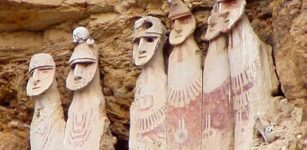Our New Relative: ‘Homo Luzonensis’ – New Species Of Early Human Found
Conny Waters - AncientPages.com - The remains of a new species of human have been uncovered by researchers excavating Callao Cave on Luzon Island, Philippines. This region of our planet apparently played a significant role in hominin evolutionary history.
No DNA has been produced from the new findings, which comes from two adults and one young person. According to the researchers, one of the individuals lived about 67,000 years ago, another about 50,000 years ago.
Callao Cave, Luzon Island, Phillipines, where the remains where found. Credits: AP/TT
The new species, Homo luzonensis is named after Luzon Island, where the more than 50,000 year old fossils were found during excavations at Callao Cave.
The researchers uncovered the remains of at least two adults and one juvenile within the same archaeological deposits and according to Professor Philip Piper from The Australian National University (ANU), the findings represent a major breakthrough in our understanding of human evolution across Southeast Asia.
"The fossil remains included adult finger and toe bones, as well as teeth. We also recovered a child's femur. There are some really interesting features -- for example, the teeth are really small," Professor Piper said.
"The size of the teeth generally, though not always, reflect the overall body-size of a mammal, so we think Homo luzonensis was probably relatively small. Exactly how small we don't know yet. We would need to find some skeletal elements from which we could measure body-size more precisely" Professor Piper said.
Image shows the right upper teeth of the individual CCH6 of the newly discovered species Homo luzonensis. From left are two premolars and 3 molars. In a study released on Thursday, April 10, 2019, scientists report that tests on two samples from the species show minimum ages of 50,000 years and 67,000 years. Callao Cave Archaeology Project via AP
"It's quite incredible, the extremities, that is the hand and feet bones are remarkably Australopithecine-like. The Australopithecines last walked the earth in Africa about 2 million years ago and are considered to be the ancestors of the Homo group, which includes modern humans.
"So, the question is whether some of these features evolved as adaptations to island life, or whether they are anatomical traits passed down to Homo luzonensis from their ancestors over the preceding 2 million years."
While there are still plenty of questions around the origins of Homo luzonensis, and their longevity on the island of Luzon, recent excavations near Callao Cave produced evidence of a butchered rhinoceros and stone tools dating to around 700,000 years ago.
"No hominin fossils were recovered, but this does provide a timeframe for a hominin presence on Luzon. Whether it was Homo luzonensis butchering and eating the rhinoceros remains to be seen," Professor Piper said.
"It makes the whole region really significant. The Philippines is made up of a group of large islands that have been separated long enough to have potentially facilitated archipelago speciation. There is no reason why archaeological research in the Philippines couldn't discover several species of hominin. It's probably just a matter of time."
Homo luzonensis shares some unique skeletal features with the famous Homo floresiensis or 'the hobbit', discovered on the island of Flores to the south east of the Philippine archipelago.
In addition, stone tools dating to around 200,000 years ago have been found on the island of Sulawesi, meaning that ancient hominins potentially inhabited many of the large islands of Southeast Asia.
Written by Conny Waters – AncientPages.com Staff Writer






















